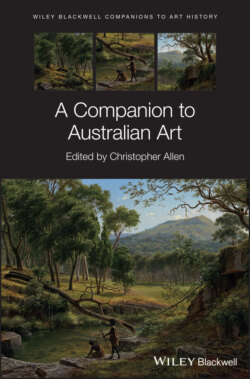Читать книгу A Companion to Australian Art - Группа авторов - Страница 18
Origins of Art Historical Writing in Australia
ОглавлениеWith the increase in immigration and economic development following the discovery of gold in 1851, art was institutionalized in Australia. Colonial governments promoted art education through the establishment of technical schools and public galleries in Sydney and Melbourne, while a number of professionally-trained European artists found employment as teachers through which they imparted knowledge of overseas trends. A sustained form of local art criticism in Australian newspapers and periodicals developed in the 1870s, playing a significant role in supporting Australia’s nascent artistic culture which looked to the European movements of romanticism and naturalism. In a review in the Melbourne Argus of the Viennese-born artist Eugene von Guérard’s View in the Grampians from the Top of the Sierra Range (1870), critic James Smith acknowledges the artist’s absolute fidelity to nature, a key attribute of colonial topographical painting and natural history illustration, yet criticizes what he perceives as von Guérard’s lack of an aesthetic reading of the landscape necessary to elevate it from a scientific treatise to a legitimate work of art (Smith 1975, 162–163). In contrast, Russian-born Nicholas Chevalier’s The Buffalo Ranges (1864) is praised for marrying “the grandest reminiscences of the old world”, evident in its sublime mountainous grandeur, while realizing “the effect of the sylvan sunlight peculiar to our clime”(Argus 1864, 6). Commending the introduction of plein-airism to Australia, Smith also lauds Swiss artist Abram Louis Buvelot’s Summer Afternoon, Templestowe (1866), a Barbizon School-inspired pastoral landscape, for its “general freedom of handling to which we are unaccustomed in the work of colonial painters” (Argus 1866, 5).
Literary romanticism presented an additional model for analysis, epitomized in novelist and journalist Marcus Clarke’s poetic interpretation of the “weird melancholy” of such Australian landscape painting, germinating from a sense of isolationism in a strange country. This aesthetic of alienation is captured in Clarke’s description of Buvelot’s Waterpool near Coleraine (1869):
In Australia alone is to be found the Grotesque, the Weird, – the strange scribblings of Nature learning how to write. Some see no beauty in our trees without shade, our flowers without perfume, our birds who cannot fly, and our beasts who have not yet learned to walk on all fours. But the dweller in the wilderness acknowledges the subtle charm of this fantastic land of monstrosities (Clarke 1975, 134).
By the following decade, substantial land-clearing and rapid urbanization transformed the colonial environment from a strange wilderness to an area ripe for productive labor, inspiring a shift in the aesthetic reading of the Australian landscape from Clarke’s “weird melancholy” to an emphasis on pastoral wealth and the notion of progress through work.
Inspired by Buvelot’s plein-air technique, a number of artists including Tom Roberts, Arthur Streeton, Frederick McCubbin, Charles Conder, and Jane Sutherland, began painting the landscape around Heidelberg on the outskirts of Melbourne in the 1880s, depicting intimate, optimistic views of the bush, epitomized in Streeton’s Golden Summer, Eaglemont (1889). Following the developments of French artist Julien Bastien-Lepage’s representation of French peasants and the British Newlyn School of artists’ portrayal of Cornish fisherfolk, these artists of the Heidelberg School also sought to capture the life of the bush settler. This interest intensified in the years surrounding the centenary of the British settlement of Australia in 1888, wherein nostalgia for a lost pioneering past replaced by urban and industrial development was combined with a progressive nationalist idealism channeled through a vision of rural landscape and labor (Galbally 2011). Such nostalgic nationalism was promoted by the writers of the Bulletin magazine, “The Bushman’s Bible”, who championed the unique Australian virtues of mateship and egalitarianism. A similar approach was advocated by the American critic Sidney Dickinson who, in the article, “What Should Australian Artists Paint?”, encourages the embrace of familiar subjects expressive of Australian life and culture: “It should be the ambition of our artists to present on canvas the earnestness, rigor, pathos and heroism of the life that is about them” (Dickinson 1975, 250). While Dickinson proposes the “characteristic life of the station and the bush” as appropriate material for Australian artists, he also suggests that the “mixed life of the city” would “furnish countless subjects”. This appealed to the urban bohemianism of the Heidelberg School group who were entrenched in cosmopolitan Melbourne society and were interested in contemporary developments in international Impressionism and the Aesthetic Movement, culminating in their 9 × 5 Impression Exhibition in 1889 (Dickinson 1975, 249–250).
In the wake of Federation and Australia’s participation in the First World War, the Australian digger came to be seen as the natural descendent of the nineteenth-century bushman. The painters associated with the Heidelberg School, especially Arthur Streeton, were canonized as the founders of a distinctively Australian art that directly engaged with the local landscape, while earlier colonial artists were criticized for what was perceived as their reliance on imported artistic formulae. For Frederick McCubbin, one of the central members of the Heidelberg School, the connection between landscape painting and national identity was critical in creating a nationalist iconography. In “Some Remarks on the History of Australian Art” (1916), he highlights the inability of colonial artists to “understand the Gum”, citing Louis Buvelot as the link between such “Pioneer Artists” and the Heidelberg School for his “genius to catch and understand the salient living features of this country” (McCubbin 1975, 269–270). Critical of cosmopolitan culture and emerging modernist trends as well as the increasing number of artists traveling overseas to Paris and London, McCubbin concludes by asserting that “the Australian artist can best fulfill his highest destiny, by remaining in his own country, and studying that which lies about him…” (McCubbin 1975, 276).
